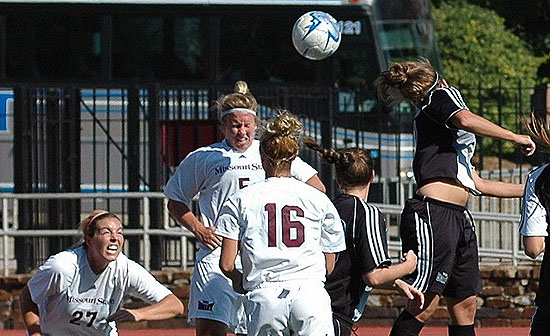The number of sports related concussions appears to be increasing and there is a growing interest in sport related concussions (McKeever & Schatz, 2003). Because of the possibility of neurological damage, traumatic brain injuries are particularly serious and warrant attention. While much of the research on concussions focuses on men’s football and hockey, there is more analyses of concussions in women’s sport appearing. Obtaining sound data on the incidence of concussions is complicated by variability in reporting and diagnosis. Emerging research in prevention and training practices show that gender-conscious approaches to physical training and conditioning for female athletes help to reduce the likelihood of concussions.
Facts and Research Findings
- Females participating in high school sports now have a higher incidence rate of sport-related concussions than do males (Gessel et al., 2007; Powell & Barber-Foss, 1999; Covassin et al., 2003)
- Among women’s sports, the highest incidence of concussions occurs in soccer (Covassin et al., 2003; Gessel et al., 2007).
- In a ranking of high school and college sports on the basis of concussions as a percentage of all injuries, women’s soccer and basketball ranked highest, followed by football and men’s soccer (Gessel et al., 2007).
- In soccer and basketball, at both high school and collegiate levels females sustain higher rates of concussions than males (Hootman, Dick & Agel, 2007; Covassin et al., Gessel et al., 2007).
- Among collegiate ice hockey players, women sustain higher levels of concussions than men (Hootman, Dick & Agel, 2007).
- Younger athletes appear to be at increased risk for concussions. This may be the result of younger brains being more susceptible to traumatic brain injury but there is no conclusive evidence on the reasons for the increased susceptibility (Covassin et al., 2003; Gessel et al., 2007; McKeever & Schatz, 2003).
- Research on risk factors for concussions is at a preliminary stage. In attempting to explain the observed sex differences in concussion rates, attention is being directed to biomechanical, neuroanatomical and neuromuscular factors but little is known about this topic (Covassin et al. 2003; Gessel et al., 2007; McKeever & Schatz, 2003).
- There is need for a more widespread understanding of the potentially dangerous impart of concussions in sport (McKeever & Schatz, 2003)
Explore Further with Concussion Articles, Position Statements and Other Resources >>>
Covassin, T., Swanik, C. B., & Sachs, M. L. (2003). Sex differences and the incidence of concussions among collegiate athletes. Journal of Athletic Training, 38(3), 238-244.
Covassin, T., Swanik, C. B., & Sachs, M. L. (2003). Epidemiological considerations of concussions among intercollegiate athletes. Applied Neuropsychology, 10(1), 12-22.
Gessel, L. M., Fields, S. K., Collins, C. L., Dick, R. W., & Comstock, R. D. (2007). Concussions among united states high school and collegiate athletes. Journal of Athletic Training, 42(4), 495-503.
McKeever, C. K., & Schatz, P. (2003). Current issues in the identification, assessment, and management of concussions in sports-related injuries. Applied Neuropsychology, 10(1), 4-11.
Powell JW, Barber-Foss K. Traumatic brain injury in high school athletes. JAMA. 1999;282(10):958-963.
*Excerpted and adapted from Staurowsky, E. J., DeSousa, M. J., Ducher, G., Gentner, N., Miller, K. E., Shakib, S., Theberge, N., & Williams, N. (2009). Her Life Depends On It II: Sport, Physical Activity, and the Health and Well-Being of American Girls and Women. East Meadow, NY: Women’s Sports Foundation.

